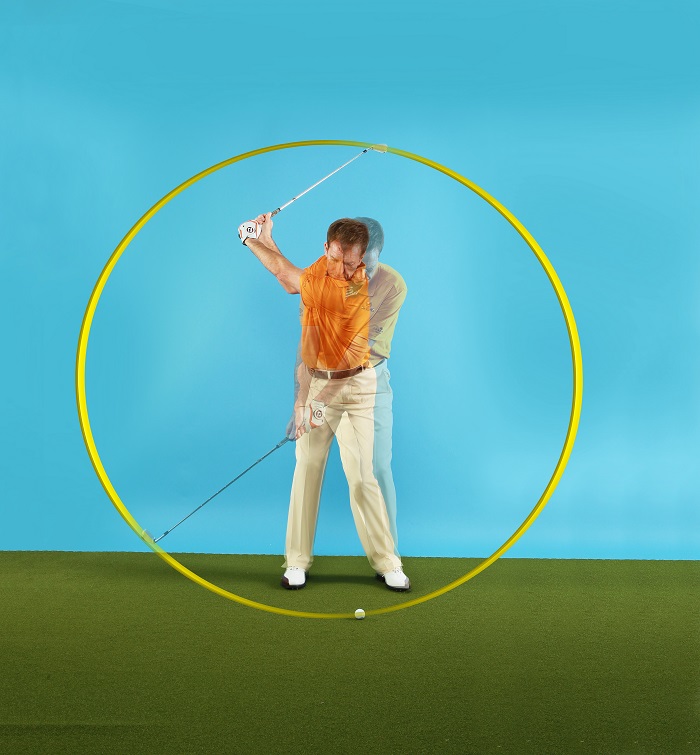The Circle Swing
– January 23, 2023 | Text Scott Cranfield

Thinking too much in golf simply doesn’t work! It slows you down, causes overwhelm and anxiety, all disastrous for playing your best golf.
If there was a ‘natural’ way to improve your golf swing so you could hit the sweet spot more often resulting in longer and straighter shots, would you be interested? If you are then please not only read this article but apply what I share and I am certain you will experience a more enjoyable game with a more effortless golf swing.
Now, I appreciate that is quite a statement, so let me give you some background. Over the last 30 years, I have probably trained more PGA coaches than anyone else and I have been consistently involved in teaching beginners through to some of the best players in the world, so I am in touch with every standard of golfer, and I have been fortunate to be awarded PGA Master Coach status.
The reason I coach is to help golfers enjoy the game with a simpler and more natural technique where they feel in control and hit accurate and powerful shots on a consistent basis without overthinking. It is my hope that the lesson shared in this article will do that for you.
I would like to introduce you to The Circle Swing, something I developed to bring the laws of your mind and body together, because that is how you end up with a golf swing that feels ‘natural’.
A big factor to The Circle Swing and why it works is you will learn to adopt an external focus and leave your body to move subconsciously, exactly the way nature intended. When your mind is focused on the circle concept you might be surprised by how well your body responds with perfect mechanics, which in turn might lead you to your biggest challenge… playing without a list of swing thoughts. If your brain is conditioned to having traditional swing thoughts, you will have to let go of these and learn to trust your subconscious. This can be quite a challenge.
Why a circle?
Apart from the fact that the golf swing represents the shape of a circle (see image 1), there are three other components that will be really helpful as you build a consistent swing.

A circle has a perimeter and for the golf swing your clubhead will track this perimeter. I want you to get a sense of how big that perimeter is, which will help you appreciate how this outer circle covered by the clubhead is quite large.
A circle has a radius, which is represented by your lead arm and club shaft. When you set up to the ball, this radius is naturally formed. Now whilst your arm and club won’t stay in a straight line throughout the swing, just having a sense of this radius can be helpful.
Finally, there is the axis or centre of the circle, and this is represented by your sternum or centre of your chest. Just like the axis of a wheel it doesn’t move around much; it operates in a small compact space.
The following exercise will help you feel, rehearse and visualise the ideal Circle Swing.
Phase 1
Take a baseball-like chest-high set up, as shown in image 2. The clubhead should be at approximately sternum height.

Imagine a plane line, level with the horizon that the clubhead will track throughout the motion.

Start with gentle swings, simply being aware of where your clubhead travels in relation to the horizontal line. See image 3. Does it stay on it? Go above? Maybe below? • If necessary, allow your body to naturally adjust its movement so the clubhead stays close to this horizontal plane line. Keep your focus on the clubhead and let your body respond. Gradually you can develop speed as you improve your movement.
Phase 2
Once you are happy you can maintain your focus on the clubhead-tracking this big circle and staying level to the horizon, it is time to lower the circle to the ground. Do this by hinging at your hips and slightly bending your knees so your spine comes forward as shown in image 4.

Put a tee peg in the ground, so your orientation is back to normal, but keep your focus 100% on the clubhead-tracking the perimeter of this large, outer circle as shown in image 5.

Even though you are now striking a tee, keep your focus on clubhead-tracking the circle and let your body respond.
Finally, of course it is time to introduce the ball, but after every 5-10 shots go back through the sequence above to ensure you are reminding yourself of these principles.
Have a realistic expectation on your results, and resist the temptation to overthink or overcorrect, just keep aware of this big circle around your body and focus on nothing else other than your clubhead tracking it and your body responding without effort. If you do this, I am certain you will enjoy the results and continue to get better.
Scott Cranfield is a PGA Master Coach. To find out more about his coaching, visit www.scottcranfield.com or contact [email protected]










